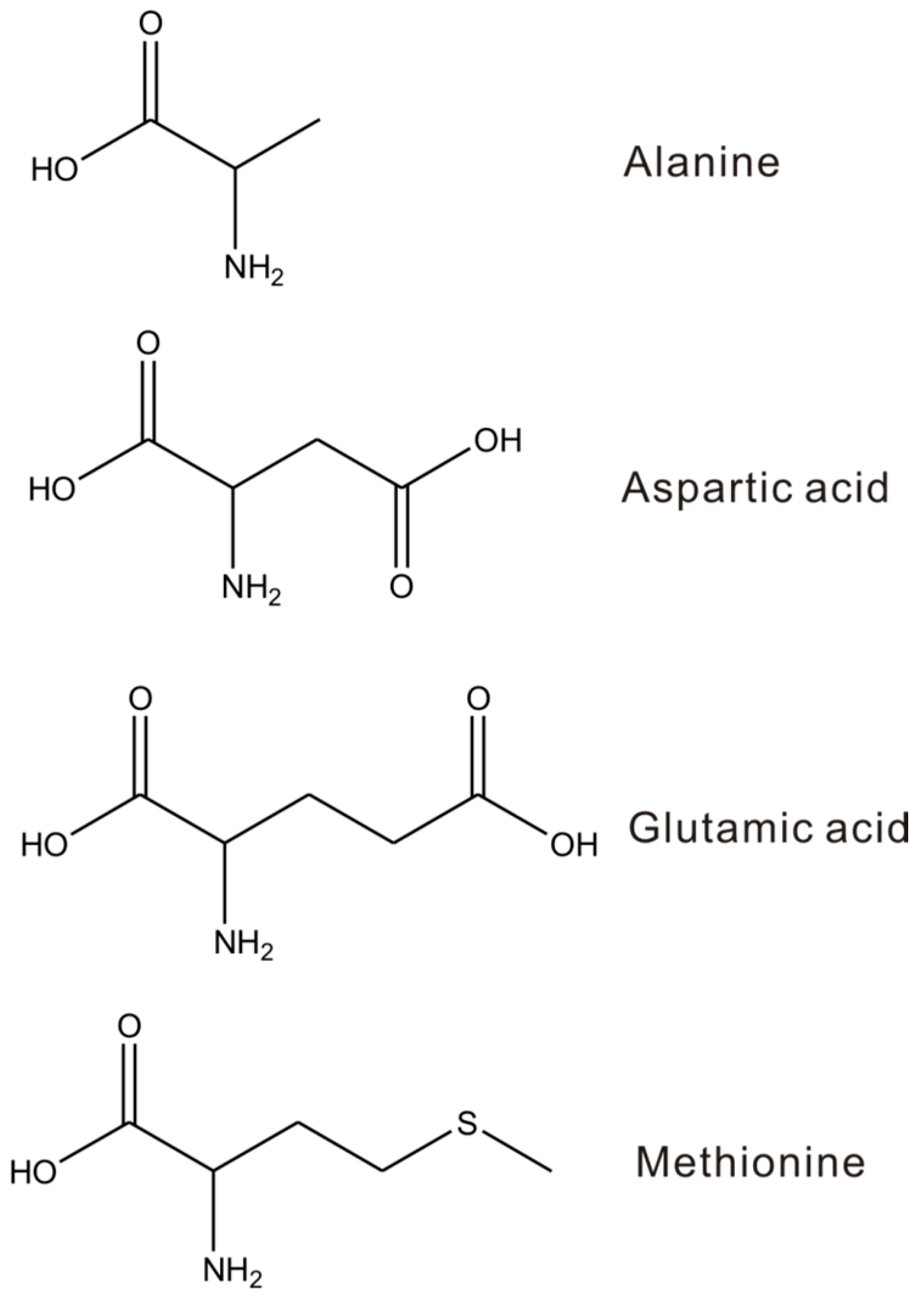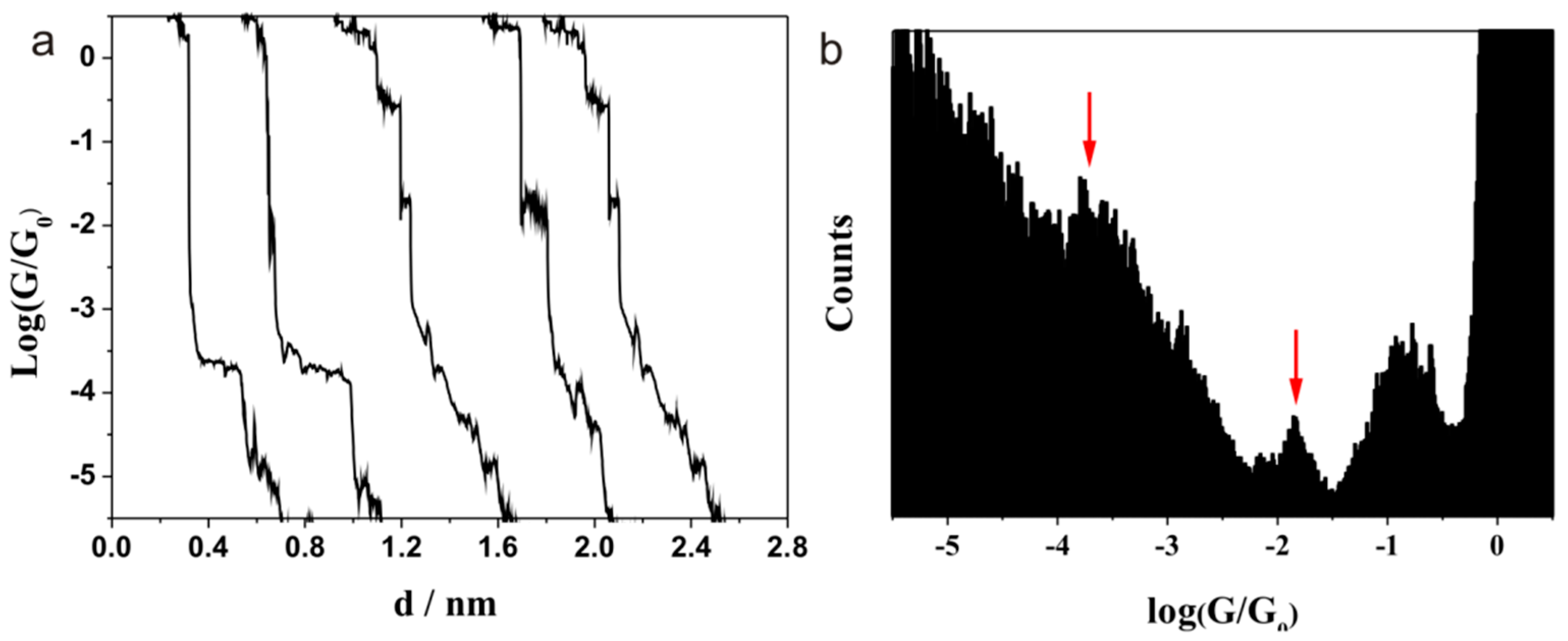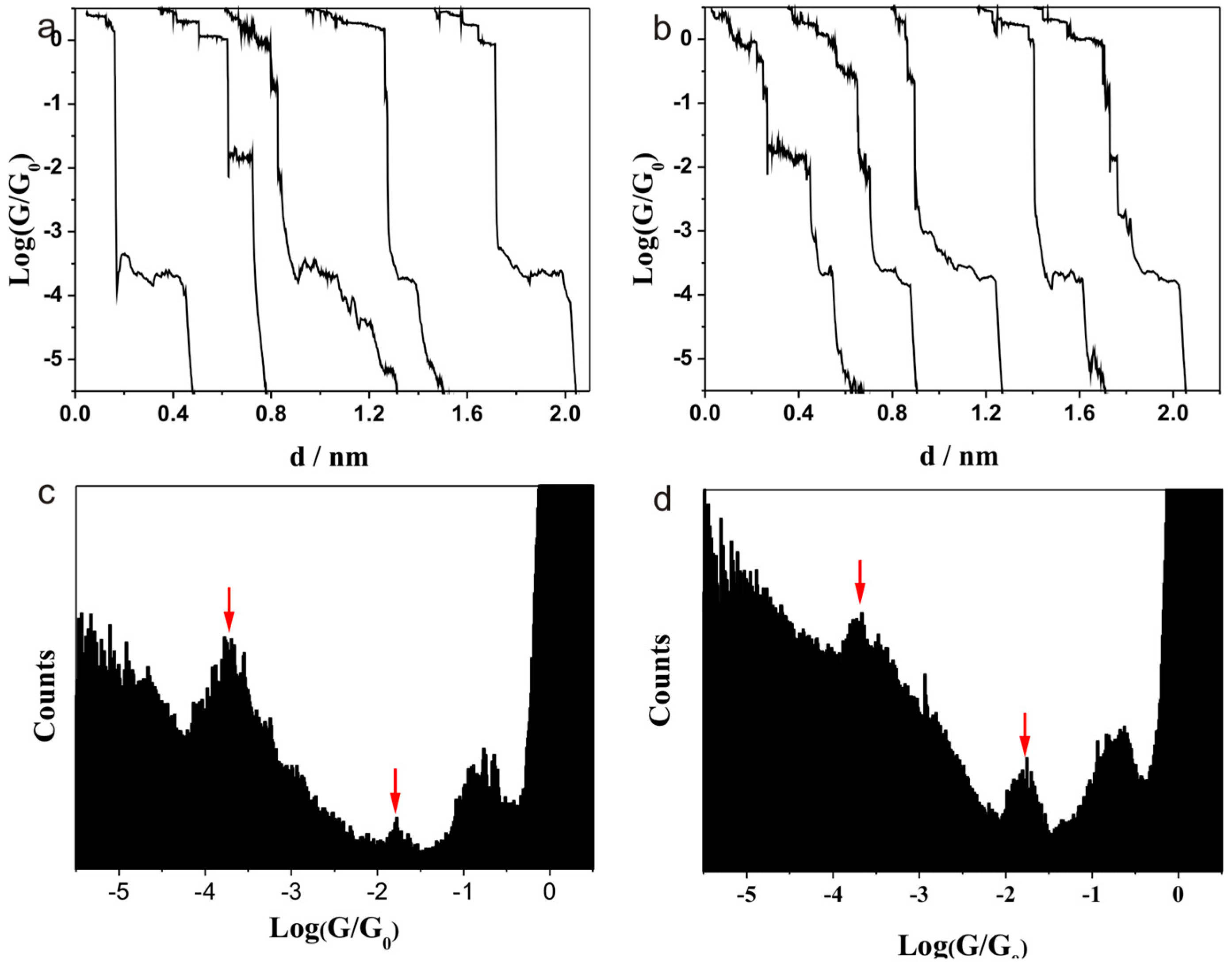Detecting Electron Transport of Amino Acids by Using Conductance Measurement
Abstract
:1. Introduction
2. Materials and Methods
3. Results and Discussion
3.1. Amino Acid Only with Anchoring Groups of Amine and Carboxylic Acid
3.2. Amino Acid with Additional Carboxylic Acid Anchoring Group Besides Amine and Carboxylic Acid
3.3. Amino Acid with Methyl Sulfide (–SMe) Anchoring Groups Besides Amine and Carboxylic Acid
4. Conclusions
Acknowledgments
Author Contribution
Conflicts of Interest
References
- Scullion, L.; Doneux, T.; Bouffier, L.; Fernig, D.G.; Higgins, S.J.; Bethell, D.; Nichols, R.J. Large conductance changes in peptide single molecule junctions controlled by ph. J. Phys. Chem. C 2011, 115, 8361–8368. [Google Scholar] [CrossRef]
- Di Ventra, M.; Taniguchi, M. Decoding DNA, rna and peptides with quantum tunnelling. Nat. Nanotechnol. 2016, 11, 117–126. [Google Scholar] [CrossRef] [PubMed]
- Shah, A.; Adhikari, B.; Martic, S.; Munir, A.; Shahzad, S.; Ahmad, K.; Kraatz, H.-B. Electron transfer in peptides. Chem. Soc. Rev. 2015, 44, 1015–1027. [Google Scholar] [CrossRef] [PubMed]
- Guo, C.L.; Wang, K.; Zerah-Harush, E.; Hamill, J.; Wang, B.; Dubi, Y.; Xu, B.Q. Molecular rectifier composed of DNA with high rectification ratio enabled by intercalation. Nat. Chem. 2016, 8, 484–490. [Google Scholar] [CrossRef] [PubMed]
- Cardamone, D.M.; Kirczenow, G. Single-molecule device prototypes for protein-based nanoelectronics: Negative differential resistance and current rectification in oligopeptides. Phys. Rev. B 2008, 77, 165403. [Google Scholar] [CrossRef]
- Sharma, V.K.; Jelen, F.; Trnkova, L. Functionalized solid electrodes for electrochemical biosensing of purine nucleobases and their analogues: A review. Sensors 2015, 15, 1564–1600. [Google Scholar] [CrossRef] [PubMed]
- Hennig, D.; Neißner, C.; Velarde, M.G.; Ebeling, W. Effect of anharmonicity on charge transport in hydrogen-bonded systems. Phys. Rev. B 2006, 73, 024306. [Google Scholar] [CrossRef]
- Schlag, E.W.; Sheu, S.-Y.; Yang, D.-Y.; Selzle, H.L.; Lin, S.H. Distal charge transport in peptides. Angew. Chem. Int. Ed. 2007, 46, 3196–3210. [Google Scholar] [CrossRef] [PubMed]
- Mitchell, P. Chemiosmotic coupling in oxidative and photosynthetic phosphorylation. Biochim. Biophys. Acta 2011, 1807, 1507–1538. [Google Scholar] [CrossRef] [PubMed]
- Sek, S.; Misicka, A.; Swiatek, K.; Maicka, E. Conductance of α-helical peptides trapped within molecular junctions. J. Phys. Chem. B 2006, 110, 19671–19677. [Google Scholar] [CrossRef] [PubMed]
- Kitagawa, K.; Morita, T.; Kimura, S. A helical molecule that exhibits two lengths in response to an applied potential. Angew. Chem. Int. Ed. 2005, 44, 6330–6333. [Google Scholar] [CrossRef] [PubMed]
- Xiao, X.Y.; Xu, B.Q.; Tao, N.J. Changes in the conductance of single peptide molecules upon metal-ion binding. Angew. Chem. Int. Ed. 2004, 43, 6148–6152. [Google Scholar] [CrossRef] [PubMed]
- Zhao, Y.; Ashcroft, B.; Zhang, P.; Liu, H.; Sen, S.; Song, W.; Im, J.; Gyarfas, B.; Manna, S.; Biswas, S.; et al. Single-molecule spectroscopy of amino acids and peptides by recognition tunnelling. Nat. Nanotechnol. 2014, 9, 466–473. [Google Scholar] [CrossRef] [PubMed]
- Ohshiro, T.; Tsutsui, M.; Yokota, K.; Furuhashi, M.; Taniguchi, M.; Kawai, T. Detection of post-translational modifications in single peptides using electron tunnelling currents. Nat. Nanotechnol. 2014, 9, 835–840. [Google Scholar] [CrossRef] [PubMed]
- Hihath, J.; Tao, N. Rapid measurement of single-molecule conductance. Nanotechnology 2008, 19, 265204. [Google Scholar] [CrossRef] [PubMed]
- Arroyo, C.R.; Frisenda, R.; Moth-Poulsen, K.; Seldenthuis, J.S.; Bjornholm, T.; van der Zant, H.S.J. Quantum interference effects at room temperature in opv-based single-molecule junctions. Nanoscale Res. Lett. 2013, 8, 1–6. [Google Scholar] [CrossRef] [PubMed]
- Xu, B.Q.; Tao, N.J. Measurement of single-molecule resistance by repeated formation of molecular junctions. Science 2003, 301, 1221–1223. [Google Scholar] [CrossRef] [PubMed]
- Perrin, M.L.; Verzijl, C.J.O.; Martin, C.A.; Shaikh, A.J.; Eelkema, R.; van EschJan, H.; van Ruitenbeek, J.M.; Thijssen, J.M.; van der Zant, H.S.J.; Dulic, D. Large tunable image-charge effects in single-molecule junctions. Nat. Nanotechnol. 2013, 8, 282–287. [Google Scholar] [CrossRef] [PubMed]
- Zheng, J.-T.; Yan, R.-W.; Tian, J.-H.; Liu, J.-Y.; Pei, L.-Q.; Wu, D.-Y.; Dai, K.; Yang, Y.; Jin, S.; Hong, W.; et al. Electrochemically assisted mechanically controllable break junction studies on the stacking configurations of oligo(phenylene ethynylene)s molecular junctions. Electrochim. Acta 2016, 200, 268–275. [Google Scholar] [CrossRef]
- Tian, J.H.; Yang, Y.; Zhou, X.S.; Schollhorn, B.; Maisonhaute, E.; Chen, Z.B.; Yang, F.Z.; Chen, Y.; Amatore, C.; Mao, B.W.; et al. Electrochemically assisted fabrication of metal atomic wires and molecular junctions by mcbj and stm-bj methods. ChemPhysChem 2010, 11, 2745–2755. [Google Scholar] [CrossRef] [PubMed]
- Tsutsui, M.; Taniguchi, M. Single molecule electronics and devices. Sensors 2012, 12, 7259–7298. [Google Scholar] [CrossRef] [PubMed]
- Sedghi, G.; Garcia-Suarez, V.M.; Esdaile, L.J.; Anderson, H.L.; Lambert, C.J.; Martin, S.; Bethell, D.; Higgins, S.J.; Elliott, M.; Bennett, N.; et al. Long-range electron tunnelling in oligo-porphyrin molecular wires. Nat. Nanotechnol. 2011, 6, 517–523. [Google Scholar] [CrossRef] [PubMed]
- Venkataraman, L.; Klare, J.E.; Nuckolls, C.; Hybertsen, M.S.; Steigerwald, M.L. Dependence of single-molecule junction conductance on molecular conformation. Nature 2006, 442, 904–907. [Google Scholar] [CrossRef] [PubMed]
- Zhou, X.S.; Liu, L.; Fortgang, P.; Lefevre, A.-S.; Serra-Muns, A.; Raouafi, N.; Amatore, C.; Mao, B.W.; Maisonhaute, E.; Schollhorn, B. Do molecular conductances correlate with electrochemical rate constants? Experimental insights. J. Am. Chem. Soc. 2011, 133, 7509–7516. [Google Scholar] [CrossRef] [PubMed]
- Rascón-Ramos, H.; Artés, J.M.; Li, Y.; Hihath, J. Binding configurations and intramolecular strain in single-molecule devices. Nat. Mater. 2015, 14, 517–522. [Google Scholar] [CrossRef] [PubMed]
- Wang, L.; Gong, Z.L.; Li, S.Y.; Hong, W.J.; Zhong, Y.W.; Wang, D.; Wan, L.J. Molecular conductance through a quadruple-hydrogen-bond-bridged supramolecular junction. Angew. Chem. Int. Ed. 2016, 55, 12393–12397. [Google Scholar] [CrossRef] [PubMed]
- Yang, Y.; Liu, J.Y.; Yan, R.W.; Wu, D.Y.; Tian, Z.Q. Mechanism and characterization of electron transport through metal/molecule/metal junctions. Chem. J. Chin. Univ.-Chin. 2015, 36, 9–23. [Google Scholar] [CrossRef]
- Zhou, X.S.; Liang, J.H.; Chen, Z.B.; Mao, B.W. An electrochemical jump-to-contact stm-break junction approach to construct single molecular junctions with different metallic electrodes. Electrochem. Commun. 2011, 13, 407–410. [Google Scholar] [CrossRef]
- Chen, Z.B.; Hong, Z.W.; Li, D.F.; Wang, Y.H.; Zheng, J.F.; Shao, Y.; Zhou, X.S. The conductance of pyridine-based molecules measured in ambient air and electrolyte solution: Effect of surrounding. Int. J. Electrochem. Sci. 2015, 10, 2931–2938. [Google Scholar]
- Chen, L.; Wang, Y.H.; He, B.; Nie, H.; Hu, R.; Huang, F.; Qin, A.; Zhou, X.S.; Zhao, Z.; Tang, B.Z. Multichannel conductance of folded single-molecule wires aided by through-space conjugation. Angew. Chem. Int. Ed. 2015, 54, 4231–4235. [Google Scholar] [CrossRef] [PubMed]
- Hong, Z.W.; Aissa, M.A.B.; Peng, L.L.; Xie, H.; Chen, D.L.; Zheng, J.F.; Shao, Y.; Zhou, X.S.; Raouafi, N.; Niu, Z.J. Quantum interference effect of single-molecule conductance influenced by insertion of different alkyl length. Electrochem. Commun. 2016, 68, 86–89. [Google Scholar] [CrossRef]
- Mao, J.C.; Peng, L.L.; Li, W.Q.; Chen, F.; Wang, H.g.; Shao, Y.; Zhou, X.S.; Zhao, X.Q.; Xie, H.; Niu, Z.J. Influence of molecular structure on contact interaction between thiophene anchoring group and au electrode. J. Phys. Chem. C 2017, 121, 1472–1476. [Google Scholar] [CrossRef]
- Chen, F.; Peng, L.L.; Hong, Z.W.; Mao, J.C.; Zheng, J.F.; Shao, Y.; Niu, Z.J.; Zhou, X.S. Comparative study on single-molecule junctions of alkane- and benzene-based molecules with carboxylic acid/aldehyde as the anchoring groups. Nanoscale Res. Lett. 2016, 11, 380. [Google Scholar] [CrossRef] [PubMed]
- Li, C.Z.; He, H.X.; Bogozi, A.; Bunch, J.S.; Tao, N.J. Molecular detection based on conductance quantization of nanowires. Appl. Phys. Lett. 2000, 76, 1333–1335. [Google Scholar] [CrossRef]
- Li, Y.; Demir, F.; Kaneko, S.; Fujii, S.; Nishino, T.; Saffarzadeh, A.; Kirczenow, G.; Kiguchi, M. Electrical conductance and structure of copper atomic junctions in the presence of water molecules. Phys. Chem. Chem. Phys. 2015, 17, 32436–32442. [Google Scholar] [CrossRef] [PubMed]
- Afsari, S.; Li, Z.; Borguet, E. Orientation-controlled single-molecule junctions. Angew. Chem. Int. Ed. 2014, 53, 9771–9774. [Google Scholar] [CrossRef] [PubMed]
- Komoto, Y.; Fujii, S.; Nishino, T.; Kiguchi, M. High electronic couplings of single mesitylene molecular junctions. Beilstein J. Nanotechnol. 2015, 6, 2431–2437. [Google Scholar] [CrossRef] [PubMed]
- Kiguchi, M. Electrical conductance of single c60 and benzene molecules bridging between pt electrode. Appl. Phys. Lett. 2009, 95, 073301. [Google Scholar] [CrossRef]
- Kim, T.; Vázquez, H.; Hybertsen, M.S.; Venkataraman, L. Conductance of molecular junctions formed with silver electrodes. Nano Lett. 2013, 13, 3358–3364. [Google Scholar] [CrossRef] [PubMed]
- Aradhya, S.V.; Frei, M.; Halbritter, A.; Venkataraman, L. Correlating structure, conductance, and mechanics of silver atomic-scale contacts. ACS Nano 2013, 7, 3706–3712. [Google Scholar] [CrossRef] [PubMed]
- Den Boer, D.; Coenen, M.J.J.; van der Maas, M.; Peters, T.P.J.; Shklyarevskii, O.I.; Elemans, J.A.A.W.; Rowan, A.E.; Speller, S. Electron transport through co studied by gold break-junctions in nonpolar liquids. J. Phys. Chem. C 2009, 113, 15412–15416. [Google Scholar] [CrossRef]
- Chen, F.; Li, X.L.; Hihath, J.; Huang, Z.F.; Tao, N.J. Effect of anchoring groups on single-molecule conductance: Comparative study of thiol-, amine-, and carboxylic-acid-terminated molecules. J. Am. Chem. Soc. 2006, 128, 15874–15881. [Google Scholar] [CrossRef] [PubMed]
- Fatemi, V.; Kamenetska, M.; Neaton, J.B.; Venkataraman, L. Environmental control of single-molecule junction transport. Nano Lett. 2011, 11, 1988–1992. [Google Scholar] [CrossRef] [PubMed]
- Kotiuga, M.; Darancet, P.; Arroyo, C.R.; Venkataraman, L.; Neaton, J.B. Adsorption-induced solvent-based electrostatic gating of charge transport through molecular junctions. Nano Lett. 2015, 15, 4498–4503. [Google Scholar] [CrossRef] [PubMed]
- Batra, A.; Darancet, P.; Chen, Q.; Meisner, J.S.; Widawsky, J.R.; Neaton, J.B.; Nuckolls, C.; Venkataraman, L. Tuning rectification in single-molecular diodes. Nano Lett. 2013, 13, 6233–6237. [Google Scholar] [CrossRef] [PubMed]
- Frei, M.; Aradhya, S.V.; Hybertsen, M.S.; Venkataraman, L. Linker dependent bond rupture force measurements in single-molecule junctions. J. Am. Chem. Soc. 2012, 134, 4003–4006. [Google Scholar] [CrossRef] [PubMed]
- Ahn, S.; Aradhya, S.V.; Klausen, R.S.; Capozzi, B.; Roy, X.; Steigerwald, M.L.; Nuckolls, C.; Venkataraman, L. Electronic transport and mechanical stability of carboxyl linked single-molecule junctions. Phys. Chem. Chem. Phys. 2012, 14, 13841–13845. [Google Scholar] [CrossRef] [PubMed]




| Molecules | Conductance (nS) |
|---|---|
| Alanine | 1095, 15.5 |
| Aspartic acid | 1095, 15.5 |
| Glutamic acid | 1095, 15.5 |
| Methionine | 77.5 |
© 2017 by the authors. Licensee MDPI, Basel, Switzerland. This article is an open access article distributed under the terms and conditions of the Creative Commons Attribution (CC BY) license (http://creativecommons.org/licenses/by/4.0/).
Share and Cite
Li, W.-Q.; Huang, B.; Huang, M.-L.; Peng, L.-L.; Hong, Z.-W.; Zheng, J.-F.; Chen, W.-B.; Li, J.-F.; Zhou, X.-S. Detecting Electron Transport of Amino Acids by Using Conductance Measurement. Sensors 2017, 17, 811. https://doi.org/10.3390/s17040811
Li W-Q, Huang B, Huang M-L, Peng L-L, Hong Z-W, Zheng J-F, Chen W-B, Li J-F, Zhou X-S. Detecting Electron Transport of Amino Acids by Using Conductance Measurement. Sensors. 2017; 17(4):811. https://doi.org/10.3390/s17040811
Chicago/Turabian StyleLi, Wei-Qiong, Bing Huang, Miao-Ling Huang, Lin-Lu Peng, Ze-Wen Hong, Ju-Fang Zheng, Wen-Bo Chen, Jian-Feng Li, and Xiao-Shun Zhou. 2017. "Detecting Electron Transport of Amino Acids by Using Conductance Measurement" Sensors 17, no. 4: 811. https://doi.org/10.3390/s17040811






